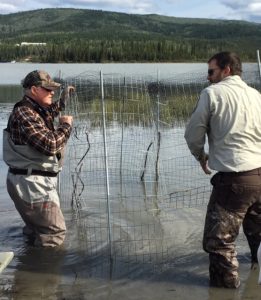By Poppy Benson, Friends Board Vice President
|
By Poppy Benson, Friends Board Vice President
|
By: Leslie Slater, Friends Kodiak Refuge Liaison
Let me back up and tell you all about the trip that Friends’ Vice President Poppy Benson and I as Kodiak Refuge Liaison had the pleasure of taking in October around National Wildlife Refuge Week.
The Refuge had asked us to come help with events, but we also had things we wanted to accomplish with several local groups. The Friends group has a small footprint in Kodiak and we wanted to increase that by telling folks what our mission is, how we can help them, and encourage them to join Friends.First up was a volunteer appreciation event cohosted with the Kodiak Refuge that acknowledged the efforts of people who contributed their time to Kodiak Refuge projects. The refuge normally held these events annually, but had been unable to do so over the past two years due to the pandemic. More than 30 people attended on a blustery, rainy evening, and we helped lure them in by providing locally catered finger foods. Most of the refuge’s volunteers have been assisting with projects for several years, and one began his association with refuge projects in the 1970s!
The following day, with only an occasional bit of precip falling and the tiniest bit of blue sky taunting us, we set up a Friends table under a tent shared with the refuge at the “Walk for the Wild” event. The refuge visitors services staff set up a walking route that had trivia questions posted throughout and a photo scavenger hunt. Walkers set off with their clip boards and answer sheets to win rewards based on the number of correct answers. With 103 participants, this was the largest Walk for the Wild in Alaska. Many, many families with small children participated and all seemed to have a very good time. And personally, there was a bonus…. I even ticked a bucket-list item off: donning (and dancing in!) the brown bear costume that the refuge keeps on hand for such events.

Kodiak Refuge Manager Michael Brady; bear; Kodiak Volunteer Coordinator Erin Strand, with the photo stop at the Walk for the Wild banner. pc. Poppy Benson
The next day we were part of a small group who conducted a beach clean-up at White Sands Beach. It’s a few miles out of town and gets a lot of use… many firepits contained a lot of nails leftover from burning pallets. It felt good to leave the site much cleaner than it had been.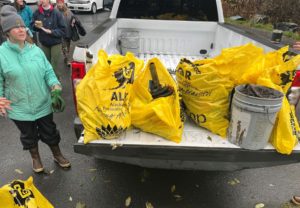
The “loot” from beach cleaning efforts with Ranger Gretchen Mominee. pc Erin Strand
Our last big public event was hosting the October Friends meeting, Tracking Puffins Across the Kodiak Archipelago. It was an electronic challenge in linking three remote locations (Portland, Homer, Soldotna) and a zoom audience to the live meeting occurring in the Kodiak Refuge Visitor Center, but it seemed to have gone off without a hitch. Twenty-six attended in Kodiak with a total audience from all locations and zoom land of 115. 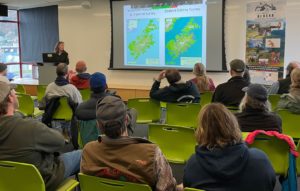
Kodiak Refuge Avian Biologist Robin Corcoran presenting to the Friends monthly meeting live to the Kodiak audience as well as the zoom and watch party audiences. Pc Poppy Benson
Poppy and I also met with the Kodiak Audubon Chapter’s board of directors, the refuge’s new Community Affairs Liaison, Amy Peterson, at her office at Koniag and the president of the Kodiak Brown Bear Trust to encourage further communications, and hopefully, partner with them on future conservation projects.
Lastly, we had a sit-down meeting with refuge staff, to outline what Friends could do for them and discuss what they most need from us. We gained five new members on this trip but planted lots of seeds for future partnerships. And, did I mention, the party at the Refuge Manager’s house?
By: Poppy Benson, Friends VP, Homer
Under the able leadership of Soldotna Friend Tim Shipman, seven Friends plus friends of Friends did their part in the Kenai Refuge’s Green-up, Clean-up on May 13 and 14. We spruced up two campgrounds and the multi purpose trail and Ski Hill road. A hot dog roast under sunny skies rewarded the trash pickers.
|
By: Poppy Benson, Friends VP, Homer
Friends came from all over to run the Friends Outreach Booth at the Kachemak Bay Shorebird Festival. Seventeen Friends from San Francisco, Colorado, Washington, Soldotna, Homer, Anchor Point, and Anchorage, got the word out on who we are, that we cosponsor the Shorebird Festival, and how we help refuges. We must have been convincing because we signed up 37 new or renewing members while having fun and meeting great people.
Board Member Mike Schantz in a rare quiet moment while working the Friends table at the 2022 Kachemak Bay Shorebird Festival. pc: Becky Hutchinson |
By:Pam Seiser, Fairbanks Friend
Three Fairbanks Friends took up the invitation to visit the Arctic Interagency Visitor Center at Coldfoot to help with the Wild and Scenic Rivers Celebration last month. This two day event was organized by Patrick Magrath, Student Conservation Association Intern with the Arctic Refuge. Patrick’s goal was not only to show off the interpretative resources at the center but also outdoor resources surrounding the center. So, Don Kiely, my husband Randy Lewis, and I alternated shifts volunteering at the visitor center with exploring the surroundings. Arctic Interagency Visitor Center at Coldfoot. pc. Randy Lewis The visitor center highlights the neighboring public lands of three agencies: the Fish & Wildlife Service’s (FWS) three National Wildlife Refuges, the famous Arctic Refuge north of the visitor center and the lesser known Kanuti and Yukon Flat Refuges that straddle the Arctic Circle; the Bureau of Land Management’s Dalton Highway corridor; and the National Park Service’s Gates of the Arctic National Park. It is an inviting center, with a small auditorium, a wonderful array of interpretive displays and a cozy corner with a wood stove, chairs and a pile of reading material. Geologists involved in the construction of the road and pipeline will love that large rocks in front of the building are labeled! Also, the tour guide tells us that the center is known for having the cleanest bathroom in 200 miles. Patrick Magrath of the Arctic Refuge with some of the exhibits about Wild and Scenic Rivers. At the end of the first day we arrived at FWS cabins provided for visiting staff just north of the Marion Creek Campgrounds and Coldfoot. We helped set up displays the morning of the event and then served as greeters while Don hiked along the Chandalar Shelf. On Sunday, Don was the greeter, and we drove to Atigun Pass. The evening talks for Wild and Scenic Rivers drew a crowd of 30 people, which was a success. About 75-80 visitors a day dropped by the center. Visitation is high at the start of the summer and drops sharply after July 4th, the start of the mosquito season. When we had no visitors we pumped the staff for information on hikes. We learned Kanuti has hot springs! Milepost 103 is the jumping off point for the 14-mile hike/packboat trip to the hot springs. Inside the Arctic Interagency Visitor Center at Coldfoot. pc. Randy Lewis |
By: Poppy Benson, Friends Vice President
|
By: Nancy Deschu, Friends member and retired hydrologist from Anchorage. She is the refuge liaison for Alaska-Peninsula/Becharof Refuges.
Our Friends’ trip to Tetlin National Wildlife Refuge Memorial Day weekend was all about water. It was sunny and hot and the refuge was in flood stage. Our original plan to canoe and flag a trail along Desper Creek changed – the water was so high camp sites would be flooded and it would be impossible to paddle back upstream. After bringing breakfast to the refuge staff, we eight Friends helped Ranger Tim Lorenzini with the annual roadside cleanup. We then trailered refuge canoes to Deadman Lake for use by refuge visitors, and set up camp at Deadman Lake. Over the next four days, we made site visits to check on trails and flood conditions along the refuge’s north boundary all the way to the border of Canada.
Water from snow melt, glacial melt, and rainfall in the Nutzotin and Mentasta mountains drives the vast wetlands of the Tetlin Refuge. The Chisana River (meaning “Rock River” in Upper Tanana language) and the Nabesna River (meaning “Along the Muddy River” in Ahtna language) head in high peaks in Wrangell St Elias National Park and Preserve, then flow north about 70 miles, and pour into the refuge. Hot, sunny weather in May caused extreme melting in a year with high snowpack so we found high water wherever we went. The boat ramp at Scottie Creek was two feet underwater.
We estimated the high flow at the Scottie Creek bridge by dropping sticks from the bridge and timing the flow of sticks over a set distance with a stopwatch. We estimated the surface flow to be nearly three feet per second, which is quite fast for the low gradient and otherwise sluggish Scottie Creek. The lake level at Hidden Lake had risen so much that it floated and then swamped two jon boats stashed in the lakeshore spruce woods.
Friends in the birding blind in Tetlin Refuge’s Lakeview Campground. pc: Poppy Benson
We canoed the entire shoreline of Deadman Lake looking at birds and potential backcountry campsites. Highlights were several species of warblers flying out of spruce trees over the water to feed on insects, horned grebes, swans and Hudsonian godwits. We sighted 40 bird species on the refuge including a diversity of ducks. Ducks were abundant on Yarger Lake, but noticeably fewer were observed on Deadman Lake. No waterfowl were observed on Hidden Lake.
 Nancy Deschu and two girls from the campground examine captured aquatic invertebrates. pc: Tom Chard
Nancy Deschu and two girls from the campground examine captured aquatic invertebrates. pc: Tom Chard
At Deadman Lake we sieved the shallows for aquatic invertebrates. A joyful happenstance was meeting two girls who were fascinated with invertebrates and netting their own trove. We exchanged specimens in our makeshift aquaria and spent considerable time identifying and observing the creatures. The girls’ knowledge was impressive!
Although our Tetlin trip was not what we had planned, we were able to contribute our observations on the refuge during unusually high water and enjoy camping and birding on the refuge.
By: Dan Musgrove; Soldotna, Alaska
In March of 2022 I joined Ralph Kiehl along with Ranger Tim Lorenzini of the Tetlin National Wildlife Refuge for the purpose of maintaining remote cabins on the refuge. Over a one week period the work involved cutting firewood, repairing a cabin porch, inventorying cabin supplies, hauling propane and a generator and taking snow depths for biologists. The fun involved meeting new people, seeing a refuge I had not been to, ice fishing, snow machining and sharing meals.
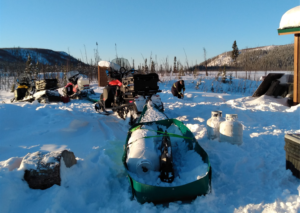
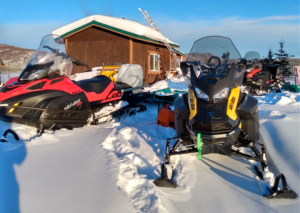
Stuver Lake Cabin jhkhhhhhh Jatahmund Cabin
Once in Tok, Ralph and I attended a snow machine safety class, gathered gear for the trip and enjoyed eating at Fast Eddies, the one restaurant in town. Our destination for this project was approximately 80 miles towards the Canadian border, with our first stop for staging at the Seaton Roadhouse. Once the snow machines were unloaded and packed we proceeded along for another 25 miles, stopping along the way to take snow depth measurements that would help the biologists.
The first cabin we reached was the Stuver Lake Cabin with a stunning lake view. After two days at this cabin shoveling snow, cutting wood and making repairs we headed another 15 miles to Jatahmund Lake Cabin where we spent another 2 days. We were greeted with the sight of 15 caribou on the lake. At this cabin in addition to cutting wood, shoveling snow off roof structures, our repairs included building a new toilet seat for the outhouse!

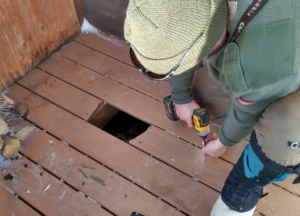
Tim measuring snow depth. hhkkkkkkkkkkkhjkk Repairing Stuver Lake cabin porch floor.

Other duties as assigned. Dan builds an outhouse seat.
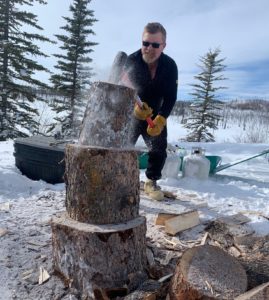
Dan was a wood-splitting machine.
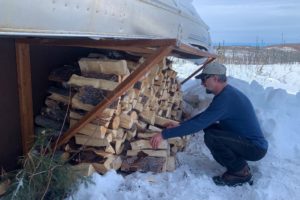
Ralph stacking wood.
Jatahmund Cabin provided amazing mountain views, sunsets, and daily sightings of caribou near the cabin. The ice fishing here was incredibly fun! Maybe a few fish tales to tell!
Ranger Tim kept Ralph and me well-fed throughout the trip, cooking was done inside the cabins on propane stoves. Gathering clean snow for drinking and cooking was a daily occurrence.
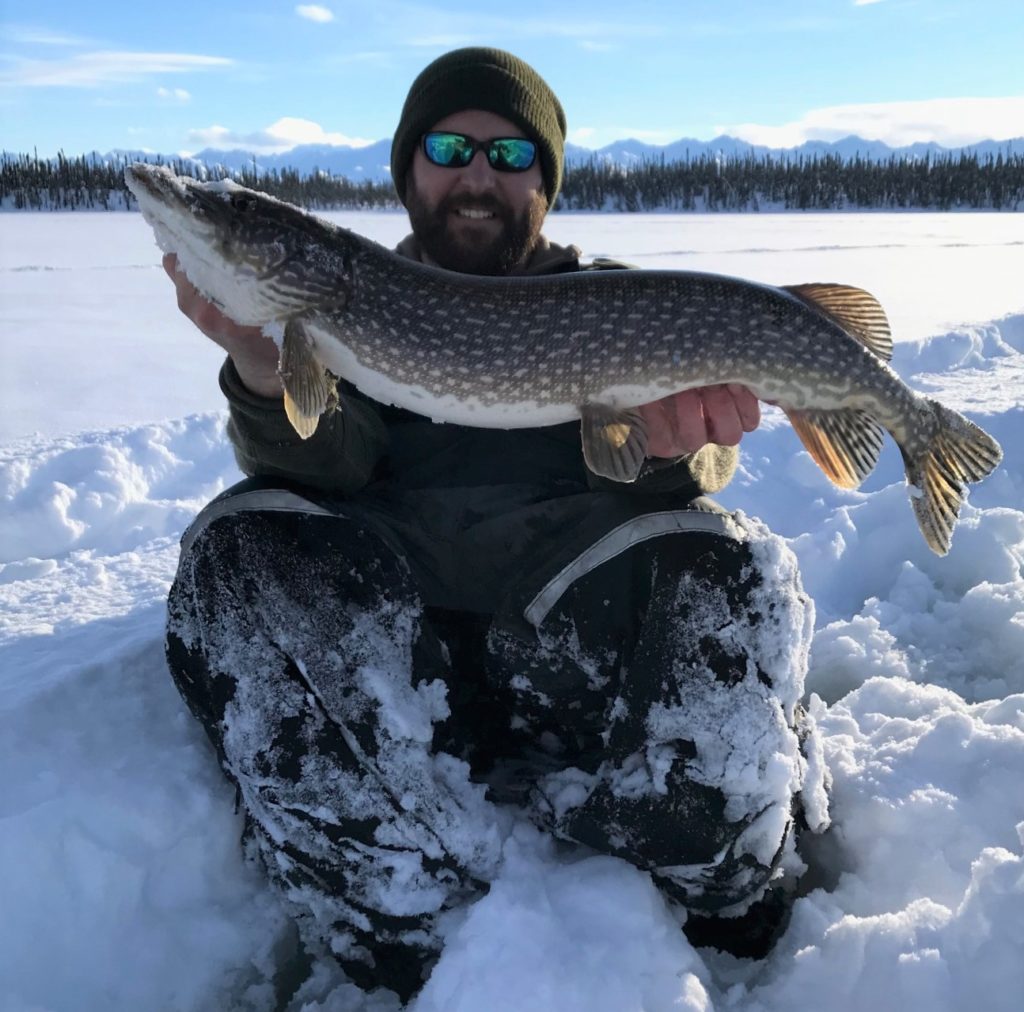
Tim and Jahtumend Lake pike.
My favorite part of this volunteer opportunity was seeing new country and sharing in the work of maintaining a refuge. Volunteering with the Refuge was gratifying and satisfying. I highly recommend volunteering if an opportunity comes your way.
By Poppy Benson
I took advantage of a personal trip through Dulles last Thursday to speak to our Alaska Senators on behalf of Friends as our Vice President. Neither Senator Murkowski or Senator Sullivan were available but I met with their staffers. Senator Murkowski’s staff was particularly engaged with my message about the FY2021 budget currently under consideration. Refuges in Alaska are down 25% in staffers since a decade ago, and we are seeing that in the work refuges are able to do and even in our ability to help them as volunteers.
Three refuges, Yukon Delta (second largest in the nation), Togiak and Koyukuk-Nowitna, have been without Refuge Managers for up to three years. Tetlin doesn’t have a full-time biologist. Izembek’s staff is down to 3 permanent employees. Administration priorities, particularly the Izembek road land exchange and drilling in the Arctic Refuge are taking funds and people away from refuge work in what could be accurately characterized as an unfunded mandate.
The good news is that the proposed 2021 budget provided a nice bump up for refuges. However, after 10 years of flat budgets, the spending power of Alaska’s refuges is still below that of a decade ago and the backlog of unfilled positions is enormous.
My message was three fold: support the nationwide refuge system budget at the $586 million level advocated by the National Wildlife Refuge Association; thank you for the extra money for invasive species management for Alaska; and Friends support Alaska refuges and will continue to advocate for them. Since my return I learned about the Great American Outdoors Act which would permanently fund the Lands and Water Conservation Fund and provide $950 million over 5 years to address the refuge system’s nation-wide maintenance backlog of $1.4 billion.
You can help. Please follow-up my visit by contacting our Senators to support the 586 million budget and the Great American Outdoors Act: https://contactsenators.com/alaska/lisa-murkowski and https://contactsenators.com/alaska/dan-sullivan. If you are not from Alaska you can find the contact information for your senators here.
